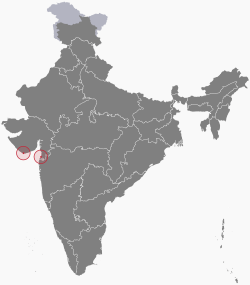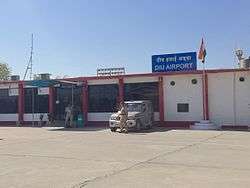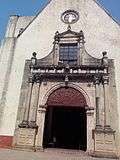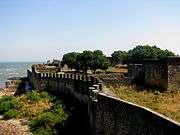Daman and Diu
| Daman and Diu | ||
|---|---|---|
| Union territory | ||
| ||
 | ||
| Coordinates: 20°25′N 72°50′E / 20.42°N 72.83°ECoordinates: 20°25′N 72°50′E / 20.42°N 72.83°E | ||
| Country |
| |
| Established | 30 May 1987 | |
| Capital | Daman | |
| Government | ||
| • Member of Parliament | Lalubhai Patel | |
| • Administrator | Praful Khoda Patel | |
| Area | ||
| • Total | 102 km2 (39 sq mi) | |
| Area rank | 35th | |
| Population (2011) | ||
| • Total | 242,911 | |
| • Rank | 6th (among union territories) | |
| • Density | 2,400/km2 (6,200/sq mi) | |
| Languages[1] | ||
| • Official |
Konkani Gujarati Hindi English | |
| • Additional official | None | |
| Time zone | IST (UTC+5:30) | |
| ISO 3166 code | IN-DD | |
| No. of districts | 2 | |
| HDI |
| |
| HDI Category | high | |
| Sex ratio | 1.61 ♂/♀ | |
Daman and Diu /dəˈmɑːn/ & /ˈdiːuː/ (![]() locally ) is a coastal union territory in India, which was once a part of the Portuguese empire neighbouring Goa.
locally ) is a coastal union territory in India, which was once a part of the Portuguese empire neighbouring Goa.
History

For over 450 years, the coastal enclaves of Daman (Portuguese: Damão) and Diu on the Arabian Sea coast were part of Portuguese India, along with Goa and Dadra and Nagar Haveli. Goa, Daman and Diu were incorporated into the Republic of India on December 19, 1961, by military conquest. Portugal did not recognise the Indian annexation of these territories until 1974.
The territory of "Goa, Daman and Diu" was administered as a single union territory until 1987, when Goa was granted statehood, leaving Daman and Diu as a separate union territory. Each enclave constitutes one of the union territory's two districts. Daman and Diu are approximately 650 kilometres away from each other by road.
Population
Demographics
According to the 2011 census, the lowest female to male ratio in India (618 females per thousand males) was recorded in Daman and Diu.[2] The Daman district, with a female to male ratio of .533, is among the lowest of all the districts in India.
Languages
Gujarati is the mother tongue of most the territory’s population, as they belong to the Gujarati-speaking Damaniya sub-caste. Along with Gujarati, Konkani, Hindi and English are all official languages. Hindi and English are official languages because they are official languages of India’s central government. Konkani is an official language since Daman and Diu were once part of a combined union territory along with Goa (a Konkani-speaking region), before Goa gained statehood in 1987.
Marathi- spoken in the neighboring state of Maharashtra- is also widely understood, although it lacks official status. The use of Portuguese, which was the territory’s official language during the colonial period, is in decline and relegated to home use among the elderly. It is also used as a liturgical language by some of the territory’s Catholics. It is no longer used by the media and it is not endorsed by the government. Standard Portuguese exists in a post-creole continuum while Daman and Diu Portuguese is spoken by about 10,000–12,000 people in Daman.
| Population growth | |||
|---|---|---|---|
| Census | Pop. | %± | |
| 1951 | 49,000 | — | |
| 1961 | 37,000 | -24.5% | |
| 1971 | 63,000 | 70.3% | |
| 1981 | 79,000 | 25.4% | |
| 1991 | 102,000 | 29.1% | |
| 2001 | 158,000 | 54.9% | |
| Source:Census of India[3] | |||
Religion
The Catholics are pastorally served by the Metropolitan Roman Catholic Archdiocese of Goa and Daman, which has its see in Goa and is the primatial see of all India.
Administration
According to the Constitution of India, Administration of Daman and Diu is carried out by an Administrator, appointed by the President of India as an agent of the President, not a head of state/government or a governor. Previously, this post was held by Shri B. S. Bhalla, IAS officer (1990 batch). He was assisted by a number of other officers in carrying out his duty. Currently, this post is held by Praful Patel.
Districts
- Diu District, an area of 40 km². The main settlement is the town of Diu.
- Daman District, an area of 28 sq mi or 72 km². The main settlement is the city of Daman.
Economy
The states domestic product for Daman and Diu in 2005 was estimated at 156 million US dollars at current prices.
Education
In Daman, the most popular schools are Institute of Our Lady of Fátima located in Moti Daman; Coast Guard Public School in Nani Daman; Sarvajanik Vidyalaya in Nani Daman; Shri Macchi Mahajan High School in Nani Daman; and other government institutions. There is also Daman College which has most of the educational facilities.
Transportation

Daman and Diu are connected by roads, and are 12 km from Vapi, 125 km from Surat, and 150 km from Mumbai. Vapi railway station on the Western Railway is the station nearest to Daman, and connects to all major cities. Diu Airport has commercial air services, while Daman Airport has an Indian Navy air base.
Media and communications
Print media
- Gujarat Samachar
- Gujarat mitra
- Praja Samachar
- Divya Bhaskar
- Janadesh
- DamanGanga Times
- Free Press Journal
- Deccan Chronicle
- The Times of India
- Hindustan Times
- The Hindu
- The Business Line
- The Economic Times
- The New Indian Express
- The Hans India
- The Territory Times
- Savera India
- Dainik Jagran
- Nava Bharat
- Nai Dunia
- Jansatta
- Sanmarg
Telecommunications
- Airtel, Aircel, BSNL, Idea Cellular, Reliance Mobile, Tata Docomo, Vodafone etc.
- Satellite Television:
- Radio:
Tourism
Daman and Diu houses various buildings and monuments with Portuguese styled architecture. The nearest railway junction is Veraval, which is 90 km from Diu. Major cities like Mumbai, Ahmedabad, Pune, Jabalpur (Madhya Pradesh), Dwarka and Thiruvananthapuram are directly connected to Veraval Railway Station. Delwada is 8 km from Diu.
- Jain Temple : This 18th century Jain temple is situated in northern region of Nani Daman Fort and is dedicated to Mahavir Swami. The temple is built with white marbel and has beautiful carvings. The walls have very elegant glass cover with 18th century murals that represents the life of Mahavir Swami.[4]
- Nani Daman Fort
- Diu Fort
- Fort of Moti Daman
- St. Thomas Church
- Nadia Caves
- St. Paul's Church
- Tower of Silence
- Daman Freedom Memorial
- Fortim do Mar
- Portuguese Fort
- Se Cathedral
- Beaches
- Nagoa Beach is a beach in Diu.
- Ghoghla Beach is the largest beach on the island of Diu.
- Chakratirth Beach is a beach in Diu.
- The Gomtimata Beach is a beach in Diu.
- Jallandhar beach is a beach with a Shrine. The beach is named after Jallandhar, a mythological demon who was said to be killed by Lord Krishna.[5]
-
Nani Daman Fort Entrance
-
Jampore Beach in Daman
-
.jpg)
Jain Temple, Daman
-
Diu Fort Fixed Cannons
-

St. Thomas Church, Diu
-
Diu fort
-

Nadia Caves of Diu
-
.jpg)
St. Paul's Church, Diu
-

Tower of Silence
-

sunset at devka beach,daman
-

Church in Nani Daman Fort
-

church of Bom Jesus,daman
-
Daman Freedom Memorial
-

Se Cathedral
-
View of Water Fort Prison from Diu Fort with watch tower of Diu Fort
-
Fortim do Mar
-

Portuguese Fort
-

Harbour View from Moti Daman Fort
Sister cities
Daman is a twin town of the city of Coimbra, Portugal.[6] Diu Island is twinned with the city of Loures, also in Portugal.[7]
See also
References
- ↑ "50th Report of the Commissioner for Linguistic Minorities in India" (PDF). 16 July 2014. p. 109. Retrieved 26 August 2016.
- ↑ "Ranking of States and Union territories by population size : 1991 and 2001" (PDF). Government of India (2001). Census of India. pp. 5–6. Retrieved 2012-05-12.
- ↑ "Census Population" (PDF). Census of India. Ministry of Finance India. Retrieved 2008-12-18.
- ↑ http://www.nrigujarati.co.in/tourism/174/Religious-Places/jain-temple-daman.html
- ↑ "Jallandhar Beach, Diu". www.nativeplanet.com. Retrieved 2016-05-13.
- ↑ "Damão, Índia". coimbra.pt (in Portuguese). Coimbra, Portugual: Câmara Municipal de Coimbra. 2014. Retrieved 2014-11-17.
- ↑ "Município – Cooperação externa – Diu". cm-loures.pt (in Portuguese). Loures, Portugual: Câmara Municipal de Loures. 2014. Retrieved 2014-11-17.
External links
| Wikivoyage has a travel guide for Daman and Diu. |
- Daman Administration's Official Website
- WorldStatesmen, including lists of Portuguese captains/governors of Damão and Diu
 |
 | |||
| Arabian Sea | |
Gujarat | ||
| ||||
| | ||||

